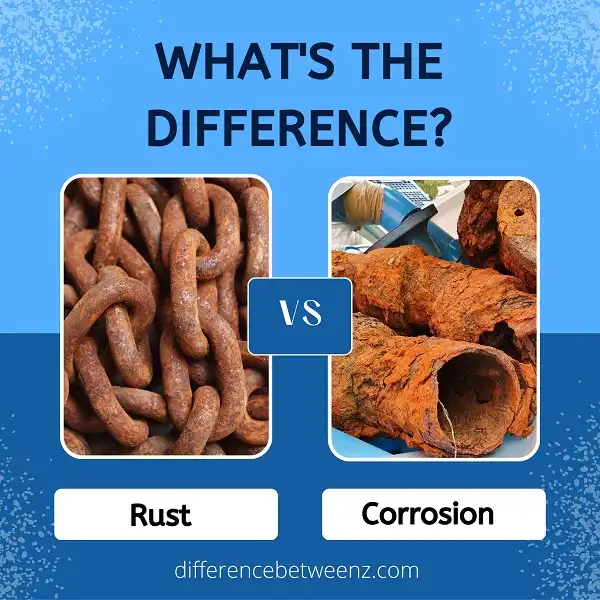When most people think of metal corrosion, they immediately think of rust. Rust is a type of corrosion, but it’s not the only one. In this blog post, we’ll take a closer look at rust and corrosion, and explain the difference between them. We’ll also talk about how to prevent or stop corrosion from happening. Stay tuned!
What is Rust?
Rust is an iron oxide, a usually red oxide formed by the redox reaction of iron and oxygen in the presence of water or air moisture. Rust is both the common name for iron oxide, and for a large group of iron oxides with different compositions.
- Rusting is the common term for corrosion of iron or its alloys, such as steel. Although rusting is often associated with the color brown, it can also take on various colors depending on the circumstances in which it forms.
- Rust consists of hydrated iron(III) oxide (Fe2O3·nH2O) and is typically associated with the degradation of ferrous metals, although it can also form on other materials.
- Rust is reddish-brown in appearance and results from the reaction between iron and oxygen in the presence of moisture. Rust seriously degrades the structural integrity of iron-containing objects such as bridges and vehicles, resulting in billions of dollars in damage each year.
- Rust is one of the most significant threats to reinforced concrete and is a major problem for both homeowners and the industry. Rust can be prevented by using Rust Inhibitors.
- Rust Inhibitors are available in many forms including paints, coatings, oils, and waxes. Rust Inhibitors work by creating a barrier between the metal and the environment, preventing oxygen and water from coming into contact with the metal.
Rust Inhibitors are available for both internal and external use and should be applied according to manufacturers’ instructions. Some Rust Inhibitors require reapplication after a certain period of time, while others claim to provide lifelong protection. When using Rust Inhibitors it is important to follow the manufacturer’s instructions carefully to ensure that the product is used correctly and effectively.
What is Corrosion?
- Corrosion is a natural process that involves the chemical reaction between a material and its environment. It can occur when metals are exposed to air, water, or other chemicals. Over time, corrosion can cause metals to weaken and deteriorate.
- In some cases, it can even lead to metal failure. Corrosion is a major problem for many industries, as it can cause expensive damage to equipment and infrastructure.
- In order to prevent corrosion, engineers must carefully select materials that are resistant to Corrosion inhibitors can also be used to slow down the process. Corrosion is an important consideration in many fields, from engineering to architecture. By understanding Corrosion, we can develop ways to protect our structures and equipment from its damaging effects.
Difference between Rust and Corrosion
Rust and corrosion are often used interchangeably, but there is a big difference between the two. Rust is a type of corrosion that occurs when iron or steel is exposed to oxygen and moisture.
- Over time, the oxygen combines with the metal to form a reddish-brown powdery substance called iron oxide. Rust can cause serious damage to iron and steel structures, and it’s not always possible to prevent it.
- Corrosion, on the other hand, is the general term for any type of deterioration that’s caused by exposure to a chemical or environment that’s hostile to the material.
- Rust is just one type of corrosion, and it usually only affects metals like iron and steel. There are many other types of corrosion that can affect different materials, including metals, plastics, and even concrete.
- While rust is often seen as a problem, corrosion actually plays an important role in many basic everyday processes. For example, the process of rusting helps to protect metals from further corrosion by forming a protective coating on the surface.
Rust also plays an important role in the food industry: it’s responsible for the distinctive flavor of damaged foods like cheese and wine. Rust can be a nuisance, but it’s also an essential part of many natural processes. without it, we would be living in a very different world.
Conclusion
Although rust and corrosion are often used interchangeably, they are two different types of metal degradation. Rust is a result of the oxidation of iron, while corrosion is a general term for any type of metal degradation. Both can be harmful to metals, but understanding the difference between them can help you take steps to prevent or slow their progression.


